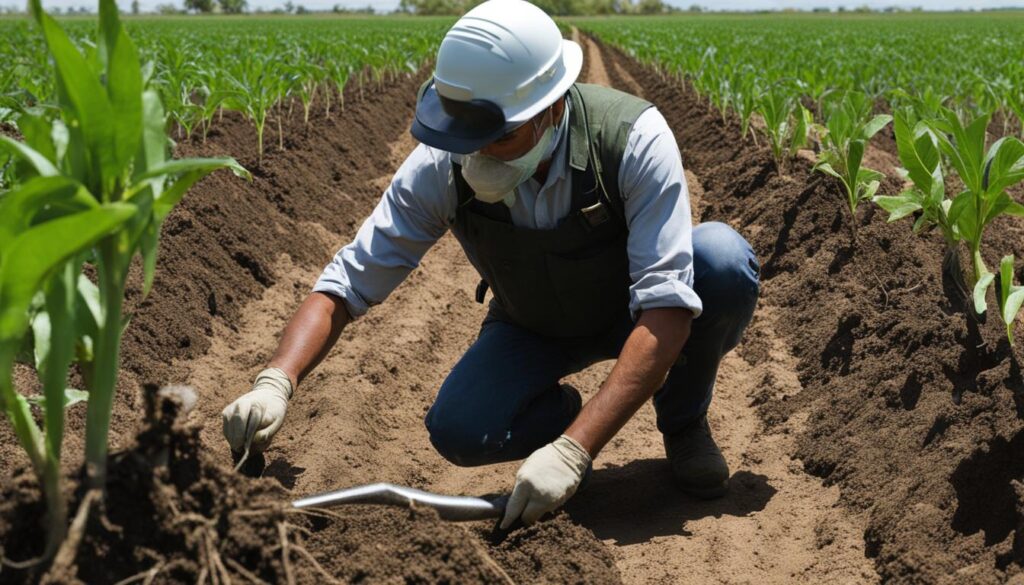In Texas, plant diseases can pose a significant threat to agricultural crops and ornamental plants. One such disease is Texas Root Rot Disease, also known as Phymatotrichum root rot.
This fungal disease, caused by Phymatotrichum omnivorum, can affect over 2,000 plant species, particularly cotton, ornamentals, and fruit, nut, and shade trees in the Southwestern United States. It thrives in calcareous clay loam soils with a pH range of 7.0 to 8.5 and in areas with high summer temperatures.
In this article, I will discuss the symptoms and signs of Texas Root Rot Disease, its causal organisms, and effective control measures to prevent its spread and manage its impact.
Key Takeaways:
- Texas Root Rot Disease, caused by Phymatotrichum omnivorum, is a destructive fungal plant disease that affects various crops and ornamental plants in Texas.
- The disease primarily occurs in calcareous clay loam soils with a pH range of 7.0 to 8.5 and in areas with high summer temperatures.
- The symptoms of Texas Root Rot Disease include wilting leaves, decayed root systems, and the presence of fungal strands and spore mats.
- The disease spreads through slow growth of the fungus in the soil and can be moved through the roots of infected plants.
- Effective control measures include crop rotation, deep plowing, the use of resistant grass crops, and careful selection of resistant ornamental plants.
Symptoms of Texas Root Rot Disease
The symptoms of Texas Root Rot Disease typically appear during the summer months when soil temperatures in Texas reach 28 °C (82 °F). Initially, plants show slight yellowing or bronzing of leaves, followed by wilting of the upper-most leaves within 24 to 48 hours. Lower leaves then wilt within 72 hours, leading to permanent wilt and eventual death. Affected plants typically die suddenly, despite having a period of excellent growth.
When pulling up an affected plant, you will discover decayed and brownish root bark, along with the presence of bronze-colored wooly strands of the fungus on the root surface. The visual identification of these symptoms is crucial for early detection and prompt management of the disease.
Causal Organisms of Texas Root Rot Disease
Phymatotrichum omnivorum is the primary fungal organism responsible for causing Texas Root Rot Disease in plants. This destructive disease affects a wide range of plant species and can have devastating consequences for agricultural and horticultural crops.
Phymatotrichum omnivorum exists in the soil in three distinct forms: hyphae and strands, sclerotia, and spore mats and conidia. The fungus produces hyphae and strands that resemble root-like structures, allowing it to penetrate the soil and infect the plant roots. These hyphae and strands can be observed as bronze-colored wooly strands on the root surface of affected plants.
Additionally, Phymatotrichum omnivorum forms sclerotia, which are small compact masses of thick-walled cells. These sclerotia can survive in the soil for many years, even at depths of up to 12 feet. The presence of sclerotia in the soil contributes to the persistent nature of Texas Root Rot Disease and its ability to re-infect susceptible plants.
During warm, rainy weather conditions, the fungus also forms spore mats on the soil surface. These spore mats contain conidia, which are asexual spores that can be dispersed by wind or water. While spore mats do not play a significant role in the direct spread of Texas Root Rot Disease, they contribute to the overall presence and survival of the fungus in the environment.
To visualize the different forms of Phymatotrichum omnivorum, refer to the following image:
Control Measures for Texas Root Rot Disease
Controlling Texas Root Rot Disease can be challenging, but there are several approaches that can be effective.
Crop rotation with monocotyledonous crops has shown reductions in disease incidence of up to 60 percent. By alternating susceptible crops with resistant ones, the spread of the disease can be minimized. This practice disrupts the life cycle of the pathogen and reduces the availability of host plants for the fungus.
Organic amendments, such as compost and manure from various crops, have also been successful in delaying infection and reducing root rot. These amendments enhance soil health and stimulate beneficial microbial activity, which can suppress the growth of the fungus.
Deep plowing is another control measure that can be effective in managing Texas Root Rot Disease. By plowing the soil to a depth of at least 12 inches, particularly immediately after cotton harvest, the ability of the fungus to form sclerotia is reduced. This practice helps bury and break down the fungal structures, limiting their survival and spread.
Plant barriers using resistant grass crops can be beneficial in controlling the disease. These barriers act as physical barriers, preventing the movement and spread of the fungus. Additionally, fertilizer applications that promote healthy plant growth can help enhance the plant’s natural defense mechanisms and reduce its susceptibility to the disease.
Landscape Control
When it comes to controlling Texas Root Rot Disease in a landscape setting, I recommend choosing ornamental plants that have some resistance to the disease. By selecting resistant plants, you can minimize the risk of root rot in your landscaping projects. To aid in your plant selection, you can refer to Bulletin L-2056, which provides a list of ornamental plants with resistance to root rot.
One effective way to visually enhance your landscape while protecting against Texas Root Rot Disease is to incorporate these ornamental plants strategically. Their natural resistance to the disease will not only help maintain the health and beauty of your landscape but also reduce the need for extensive management and control measures.


Remember, prevention is key when it comes to managing Texas Root Rot Disease. By carefully considering the ornamental plants you choose for your landscape, you can significantly reduce the risk of root rot and enjoy a thriving outdoor space.
The Spread of Texas Root Rot Disease
Texas Root Rot Disease is a fungal plant disease that spreads through the slow growth of the fungus in the soil, from plant to plant. The movement of fungal pathogens contributes to the spread of this destructive disease. Additionally, the roots of infected plants can transfer the fungus to new areas, exacerbating the problem.
The fungus responsible for Texas Root Rot Disease, Phymatotrichum omnivorum, has the ability to survive in the soil for many years. It can be found as deep as the roots penetrate, making it difficult to eliminate completely. As a result, infected areas often display circular patterns of dead plants that gradually enlarge over time, creating significant challenges for crop and plant health.
Cotton fields are particularly vulnerable to the spread of Texas Root Rot Disease. These fields can see an increase of 5 to 30 feet per year in affected areas, highlighting the aggressive nature of this disease. It is crucial to implement effective management strategies to contain and prevent the further spread of Texas Root Rot Disease.
By understanding the movement of fungal pathogens and the spread of Texas Root Rot Disease, we can develop proactive measures to minimize its impact. It is essential for farmers, gardeners, and landscapers to be vigilant in monitoring and managing this disease to protect their crops and plants.
Symptoms and Signs of Texas Root Rot Disease
When it comes to identifying Texas Root Rot Disease, there are several key symptoms and signs to look out for. One of the most noticeable indicators is sudden wilting of plants, typically occurring during the summer months. This wilting can happen rapidly, with the uppermost leaves wilting within 24 to 48 hours, followed by lower leaves wilting within 72 hours. The affected plants ultimately experience permanent wilting and eventual death.
Upon closer examination, the root system of infected plants will show signs of decay, appearing brownish and deteriorated. Additionally, you may observe visible fungal strands on the outer surfaces of the roots. These strands, also known as hyphae, are a clear indication of the presence of the Phymatotrichum omnivorum fungus responsible for Texas Root Rot Disease.
Another possible characteristic associated with the disease is the presence of spore mats on the soil surface near the infected plant. However, it’s important to note that the spores found within these mats are not fertile and cannot spread the disease further.
As visual aids, the image above demonstrates the wilting and decayed root system typically seen in plants affected by Texas Root Rot Disease.
Host Plants and Tolerance to Texas Root Rot Disease
Texas Root Rot Disease is known to infect over 2,300 plant species, targeting fruit trees, broadleaf deciduous trees, and shrubs. However, there are certain plant species that have demonstrated some tolerance to the disease and can resist its effects.
Native trees such as mesquite, sycamore, desert willow, and pine have shown varying degrees of resistance to Texas Root Rot Disease. These species exhibit some level of tolerance and are less likely to succumb to the disease compared to susceptible hosts.
Interestingly, monocots like grasses and palms are entirely resistant to Texas Root Rot Disease. This means that these plant species do not become infected and are not affected by the disease.
Pomegranates are one of the few fruit tree species known to possess some level of tolerance to Texas Root Rot Disease. While they may still be affected by the disease to some extent, they have shown a greater ability to withstand its impact compared to other susceptible fruit trees.
By incorporating these resistant species into your planting strategy, you can help reduce the risk of Texas Root Rot Disease in your garden or landscape. Utilizing tolerant host plants can be an effective way to mitigate the potential damage caused by this fungal disease.
Overall, understanding the host plants and their tolerance to Texas Root Rot Disease is essential for successful disease management and prevention. By selecting resistant species, you can minimize the risk of infection and protect your plants from the damaging effects of this disease.
Control Measures for Texas Root Rot Disease in Agriculture
Crop rotation, resistant cultivars, and accurate diagnosis play vital roles in the management of root rot disease. While there is no complete eradication of the disease, implementing these control measures can significantly reduce its impact.
Crop Rotation
Crop rotation is an effective strategy to prevent the spread of Texas Root Rot Disease within fields. By rotating with resistant crops such as corn, sorghum, or onions, the level of inoculum can be reduced. However, it is important to note that crop rotation alone may not completely eliminate the disease.
Resistant Cultivars
Currently, no resistant cultivars for Texas Root Rot Disease are available. However, ongoing research aims to develop resistant plant varieties that can withstand the fungal pathogen. Utilizing these resistant cultivars in the future can provide an additional layer of protection against the disease.
Diagnosis of Root Rot Disease
Accurate diagnosis is crucial for effective management of root rot disease. To diagnose root rot, it is important to collect samples of rotting and discolored roots. These samples should be examined by a trained individual who can identify the specific fungal pathogens and provide appropriate recommendations for control.
Implementing crop rotation, exploring resistant cultivars, and obtaining a proper diagnosis are essential steps in managing Texas Root Rot Disease in agriculture. Although complete elimination may not be possible, these control measures can significantly reduce the impact and protect crop yields.


Texas Root Rot in Alfalfa
Phymatotrichopsis root rot, also known as Texas Root Rot or cotton root rot, can affect alfalfa crops. This destructive fungal disease can have detrimental effects on the root system of alfalfa plants. The symptoms of phymatotrichopsis root rot include rotting of the outer surfaces of the roots, bronzing of the leaves, and sudden wilting. These symptoms can occur in late spring, as the disease tends to spread during this time.
One distinctive characteristic of Texas Root Rot in alfalfa fields is the appearance of circular spots, often referred to as fairy rings. These spots can be observed in the affected fields and tend to increase in size with rain or irrigation. If left untreated, the disease can cause significant damage to alfalfa crops, leading to reduced yields and potential loss of the crop.
This disease is most common in certain areas in the deserts of Southern California, Texas, and Arizona. It thrives in warm climates with specific soil conditions, making alfalfa crops susceptible to its spread in these regions.
To combat the spread of phymatotrichopsis root rot in alfalfa, it is crucial to implement appropriate management strategies such as crop rotation, deep plowing, and the use of resistant species. Additionally, farmers and growers should be vigilant in recognizing the symptoms of the disease and take prompt action to prevent its further spread.
Conclusion
Texas Root Rot Disease is a destructive fungal plant disease that can have devastating effects on various crops and ornamental plants. Managing and preventing this disease can be challenging, but there are effective strategies that can be implemented.
First and foremost, it is crucial to recognize the symptoms of Texas Root Rot Disease. These include wilting, decayed root systems, and the presence of fungal strands and spore mats. Proper diagnosis by a trained individual is essential for accurate identification and appropriate action.
Prevention and management strategies for Texas Root Rot Disease involve implementing crop rotation, deep plowing, and the use of resistant species. Crop rotation with resistant crops like corn, sorghum, or onions can help reduce the level of the disease within fields. Deep plowing immediately after cotton harvest can hinder the formation of fungal sclerotia. Additionally, selecting and replanting with resistant species can minimize the impact of the disease on future crops.
By being proactive in recognizing symptoms, implementing preventative measures, and replanting with resistant species, it is possible to effectively prevent or mitigate the impact of Texas Root Rot Disease. It is vital for farmers and gardeners to stay vigilant and follow recommended management strategies to protect their crops and ornamental plants from this devastating fungal disease.
FAQ
What is Texas Root Rot Disease?
Texas Root Rot Disease, also known as Phymatotrichum root rot, is a fungal plant disease caused by Phymatotrichum omnivorum. It primarily affects cotton, ornamentals, and fruit, nut, and shade trees in the Southwestern United States.
What are the symptoms of Texas Root Rot Disease?
The symptoms include yellowing or bronzing of leaves, wilting of upper-most leaves within 24 to 48 hours, wilting of lower leaves within 72 hours, and eventual death of the affected plant. Brownish decayed root bark and bronze-colored fungal strands are visible on the roots.
What are the causal organisms of Texas Root Rot Disease?
The causal organism is Phymatotrichum omnivorum, which exists in three forms: hyphae and strands, sclerotia, and spore mats and conidia. The fungus grows through the soil, forms compact masses of thick-walled cells, and produces spore mats on the soil surface during warm, rainy weather.
How can Texas Root Rot Disease be controlled?
Control measures include crop rotation with resistant monocotyledonous crops, organic amendments, deep plowing immediately after cotton harvest, plant barriers with resistant grass crops, and fertilizer applications.
How can Texas Root Rot Disease be controlled in landscaping?
Choose ornamental plants with resistance to the disease to minimize the risk of root rot. A list of such plants can be found in Bulletin L-2056.
How does Texas Root Rot Disease spread?
The disease spreads through the slow growth of the fungus in the soil from plant to plant and through the roots of infected plants that are transferred to new areas. The fungus can survive in the soil for many years and is found as deep as the roots penetrate.
What are the symptoms and signs of Texas Root Rot Disease?
Symptoms include sudden wilting of plants during the summer months, dead or dying leaves that remain attached, decayed and brown root system, visible fungal strands on the roots, and the presence of spore mats on the soil surface near the infected plant.
What plants are host to Texas Root Rot Disease?
Texas Root Rot Disease can infect over 2,300 plant species, with a preference for fruit trees, broadleaf deciduous trees, and shrubs. Native trees like mesquite, sycamore, desert willow, and pine show some resistance, while monocots like grasses and palms are totally resistant.
How can Texas Root Rot Disease be controlled in agriculture?
Control measures include crop rotation with resistant crops like corn, sorghum, or onions, although it will not eliminate the disease entirely. Currently, no resistant cultivars are available, and proper diagnosis of root rot disease is important.
Can Texas Root Rot Disease affect alfalfa crops?
Yes, Texas Root Rot Disease can affect alfalfa crops, causing rotting of the roots’ outer surfaces, bronzing of leaves, sudden wilting, and the appearance of circular spots, known as fairy rings, in fields.
What should I do to prevent and manage Texas Root Rot Disease?
To prevent and manage Texas Root Rot Disease, choose resistant plants, implement appropriate control measures, recognize the symptoms, and consider replanting with resistant species following recommended management strategies.



